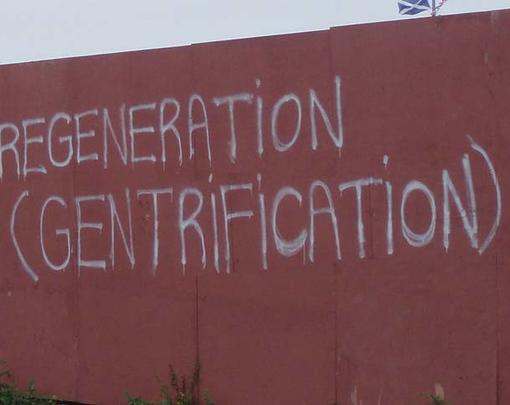BALTIMORE, MD – After months of negotiation over sale of two unused properties with the United Methodist Church in Baltimore, the Village of Love and Resistance (VOLAR) were told that another buyer making the same offer is being considered, citing “lower economic risk.”
The properties in question are two shuttered buildings on East Monument Street, formerly the Centennial Caroline Church, that would be developed by VOLAR into a hub for cooperative living, community organizing, small business incubation, and neighborhood development – even including a day-care center within the building.
By organizing residents through a community investment trust fund model, with low income investors having the opportunity to invest in land, VOLAR’s project envisioned giving the historically black and brown communities of East Baltimore an accessible path to owning a stake in their community in the face of a long history of exclusionary and speculative development practices. This path to ownership would provide East Baltimore residents a real opportunity to build wealth directly in their community. However, facing the same threat of outsider investment projects that have already led to massive gentrification across Baltimore, the fate of VOLAR’s proposal hangs in the balance.
“You have to keep in mind as we talk about these projects coming into East Baltimore that it’s all geared towards lowering redevelopment costs for the Johns Hopkins community,” said Lenora Knowles, a member of VOLAR’s Care Taking Council. “And because of that, that would eliminate any resident of the East Baltimore community without their input on the change that’s taking place.”
Facing the potential demise of a project coming directly from the East Baltimore residents, VOLAR has launched a petition calling for an additional meeting with the United Methodist Church before the official sale of the property on December 20th. There, the organizers seek to make their case for the UMC to consider them as the buyers of the currently unused properties on East Monument Street.
VOLAR itself states that, “to refuse our offer to purchase the East Monument properties would be a missed opportunity to grow love, justice, community wealth, and grassroots power in a city with deep racial and economic inequality.”
In response to community concerns about population displacement and the loss of a low-income investment opportunity, John Strawbridge, Chairman of the Board of Trustees for the Baltimore-Washington Conference of the United Methodist Church (BWCUMC), mentioned that the primary concern for selling the property was attracting vagrancy or fire. “We didn’t change buyers at any point,” said Strawbridge, “We took the best opportunity to remove the blight.”
“Their intentions are wonderful, it just wasn’t as far along or as solid as the other buyer,” he added. “Their financing plans weren’t realistic and they didn’t have the funding to get it in use or occupied.”
Strawbridge declined to mention who the other buyer was, but said that a letter of intent had been signed and the final details of the sale were being settled.
“We rejected other offers that weren’t going to be the right fit,” he said.
The funding for VOLAR’s project came about through a deep community fundraising effort that resulted in $500,000 in less than six months, all from individual donors. The mandate for a development owned by residents in the same zip-code is clear, then, as many development projects launched by actors outside the community have consistently failed to improve health and economic outcomes for the people these initiatives are designed to benefit.
“What we’re talking about here is a different strategy,” said Marisela Gomez, another member of VOLAR’s collective leadership. “We’re talking about the real way that we can work with this economy to really benefit the people who have been exploited and been told that they’re not a part of it – and we’re working with a population that everyone thinks is the most marginalized and has no right to land. We want to work with people that our cities and our states have kicked into the corner without any value.”
VOLAR’S petition has already been endorsed by East Baltimore residents, political and clergy leaders, and community organizations along with other community members, grassroots organizations and churches from throughout the city of Baltimore.
As gentrification and population displacement continue being directly relevant to the lived experience of many Americans, VOLAR’s project offers a vision of hope for East Baltimore residents to not just survive in their community, but thrive. One can only hope that the United Methodist Church sees that too.
VOLAR’s petition can be found here.




